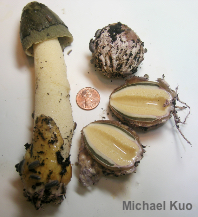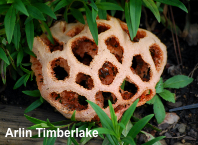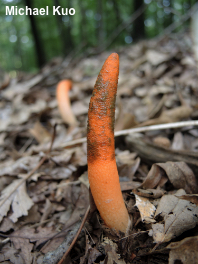| Major Groups > Stinkhorns |

|
Stinkhorns [ Basidiomycota > Agaricomycetes > Phallales . . . ] by Michael Kuo Stinkhorns are amazing mushrooms, notorious for popping up suddenly and unexpectedly in urban settings. They are very diverse in appearance, but all of them share at least two features:
Beyond these shared features, however, just about anything goes, and stinkhorns range from looking rather like morels to appearing like, um, a portion of canine anatomy, or odd marine creatures with tentacles, or crab claws, Wiffle balls, Chinese lanterns, and so on. Stinkhorns occur "naturally" in North America, especially in subtropical and tropical regions—but some stinkhorn fruitings in temperate and north-temperate climates may be caused by human endeavors, resulting from the transportation of soil, sod, woodchips, trees, and so on. Thus Lysurus mokusin appears outside a library in Lawrence, Kansas, and Aseroë rubra shows up in gardens in South Carolina. The method the stinkhorns use to disperse spores is quite ingenious, though a little disgusting to human sensibilities. The foul-smelling slime is calculated to attract flies and other insects, who land on the slime and gobble it up. Little do the insects know that they have been duped into covering their little insect feet with stinkhorn spores, and have ingested spores into their digestive tracts! Later, these spores are dispersed by the unwitting insects, and the stinkhorn life-cycle continues elsewhere. One stinkhorn, Phallus impudicus, is often mistaken for a yellow morel by summer morel hunters who are hunting with their hearts instead of their minds. However, the season alone (to say nothing of the presence of stinky slime and the underground "egg") should serve to separate the stinkhorn; morels don't grow in summer . . . and "de Nile" is not just a river in Egypt. I doubt that any mushrooms, with the possible exception of Leucocoprinus birnbaumii (which pops up out of nowhere in people's flower pots), generate more "What's This Mushroom?" emails than the stinkhorns. They are truly astonishing when they grow literally overnight in your yard or garden. So, to anticipate a few questions in advance: No, they won't hurt you (or your children, or your pets); No, I will not tell you how to get rid of them (it's pretty much impossible, but even if they were easily eradicated, why would a mushroom lover tell people how to kill mushrooms?); and Yes, I would love to see your photos (my e-mail address is on this page). Identifying stinkhorns is usually a matter of paying close attention to physical features; microscope work is rarely involved. "Phalloid" species have a well-developed stem and a clearly separated, simple cap structure, while "mutinoid" species have well-developed stems that lack a separated head (although there is an apical portion covered with spore slime, sometimes giving the appearance of a cap, the slime adheres to the stem itself). "Clathroid" species are funky things featuring arms or lattices without a well-developed stem. Lastly, "lysuroid" species seem to combine phalloid and clathroid structures; they have well-developed stems but, at the apex, the head structure features separated arms, claws, or a lattice. |
|
|
Key to 31 North American Stinkhorns Note: Some species from Central America have been included on the assumption that they may range into tropical and subtropical regions of North America. Some non-North American stinkhorns are treated at the site, but not in the key below. They include Clathrus baumii, Clathrus transvaalensis, Colus hirudinosus, Colus pusillus, Ileodictyon cibarium, Ileodictyon gracile, Lysurus corallocephalus, Lysurus gardneri, Lysurus periphragmoides, Mutinus species 01, Phallus aurantiacus, Phallus cinnabarinus, and Phallus multicolor. It should also be noted that stinkhorns are notorious for appearing where they are not supposed to appear, geographically, since they are easily spread through human endeavors.
References Abrar, S., S. Swapna & M. Krishnappa (2007). Dictyophora cinnabarina. Current Science 92: 1219–1220. Abrar, S., S. Swapna & M. Krishnappa (2012). Development and morphology of Lysurus cruciatus—an addition to the Indian mycobiota. Mycotaxon 122: 217–282. Acharya, K., P. Pradhan, N. Chakraborty, A. K. Dutta, S. Saha, S. Sarkar & S. Giri (2010). Two species of Lysurus Fr.: addition to the macrofungi of West Bengal. Journal of the Botanical Society of Bengal 64: 175–178. Akata, I. & C. T. Gürkanli (2018). A new genus record for Turkish clathroid fungi. Mantar Dergisi 9: 36–38. Alves, C. R. & V. G. Cortez (2016). Gasteroid Phallomycetidae (Basidiomycota) from the Parque Estadual São Camilo, Paraná, Brazil. Iheringia Serie Botanica 71: 27–42. Arora, D. & W. Burk (1982). Clathrus archeri, a stinkhorn new to North America. Mycologia 74: 501–504. Baseia, I. G., L. C. Maia & F. D. Calonge (2006). Notes on Phallales in the neotropics. Boletín de la Sociedad Micológica de Madrid 30: 87–93. Blanton, R. L. & W. Burk (1980). Notes on Pseudocolus fusiformis. Mycotaxon 12: 225–234. Burk, W. R. (1979). Clathrus ruber in California and worldwide distributional records. Mycotaxon 8: 463–468. Cabral, T. S., P. Marinho, B. T. Goto & I. G. Baseia (2012). Abrachium, a new genus in the Clathraceae, and Itajahya reassessed. Mycotaxon 119: 419–429. Cabral, T. S., C. R. Clement & I. G. Baseia (2015). Amazonian phalloids: new records for Brazil and South America. Mycotaxon 130: 315–320. Cabral, T. S., B. DB. Silva, M. P. Martín, C. R. Clement, K. Hosaka & I. G. Baseia (2019). Behind the veil—exploring the diversity in Phallus indusiatus s. l. (Phallomycetidae, Basidiomycota). MycoKeys 58: 103–127. Cabral, T. S., G. S. C. Melanda, N. M. de Assis, C. Ovrebo, I. G. Baseia & M. P. Martín (2022). Loosening the belt: unknown diversity of the strangled stinkhorn genus Staheliomyces (Phallales, Basidiomycota). Mycological Progress 21: 46. Calonge, F. D., G. Guzmán & F. Ramírez-Guillén (2004). Observaciones sobre los Gasteromycetes de México depositados en los herbarios XAL y XALU. Boletín de la Sociedad Micológica de Madrid 28: 337–372. Calonge, F. D. (2005). A tentative key to identify the species of Phallus. Boletín de la Sociedad Micológica de Madrid 29: 9–17. Calonge, F. D., M. Mata & J. Carranza (2005). Contribución al catálogo de los Gasteromycetes (Basidiomycotina, Fungi) de Costa Rica. Anales del Jardín Botánico de Madrid 62: 23–45. Coetzee, J. C. (2010). Taxonomic notes on the Clathraceae (Phallales: Phallomycetidae) sensu Bottomley and a new key to the species in southern Africa. Bothalia 40: 155–159. Coker, W. C. & J. N. Couch (1928). The Gasteromycetes of the eastern United States and Canada. North Carolina: University of North Carolina Press (Dover reprint, 1974). Cortez, V. G., I. G. Baseia & R. M. B. da Silveria (2011). Gasteroid mycobiota of Rio Grande do Sul State, Brazil: Lysuraceae (Basidiomycota). Maringá 33: 87-92. Cunningham, G. H. (1944/1979). The gasteromycetes of Australia and New Zealand. Germany: J. Cramer. Degreef, J., M. Amalfi, C. Decock & V. Demoulin (2013). Two rare Phallales recorded from São Tomé. Cryptogamie, Mycologie 34: 3–13. Desjardin, D. E. & B. A. Perry (2009). A new species of Phallus from São Tomé, Africa. Mycologia 101: 545–547. Desjardin, D. E. & B. A. Perry (2015). Clavarioid fungi and Gasteromycetes from Republic of São Tomé and Príncipe, West Africa. Mycosphere 6: 515–531. Dring, D. M. (1964). Gasteromycetes of West Tropical Africa. Mycological Papers 98: 1–59. Dring, D. M. & R. W. Rayner (1967). Some gasteromycetes from eastern Africa. Journal of the East Africa Natural History Society 26: 5–46. Dring, D. M. & A. C. Rose (1977). Additions to West African phalloid fungi. Kew Bulletin 31: 741–751. Dring, D. M. (1980). Contributions toward a rational arrangement of the Clathraceae. Kew Bulletin 35: 1–96. Gogoi, G. & V. Parkash (2014). Some new records of stinkhorns (Phallaceae) from Hollongapar Gibbon Wildlife Sanctuary, Assam, India. Journal of Mycology 490847, 8 pp. Gogoi, G. & V. Parkash (2015). Lysurus habungianus sp. nov. (Phallaceae)—a new stinkhorn fungus from India. Current Research in Environmental & Applied Mycology 5: 248–255. Guzmán, G. (1984). Nuevos registros de Lysurus periphragmoides de México. Boletín de la Sociedad Mexicana de Micología 19: 169–171. Guzmán, G., L. Montoya & V. M. Bandala (1990). Las especies y formas de Dictyophora (Fungi, Basidiomycetes, Phallales) en México y observaciones sobre su distribucion en america latina. Acta Botanica Mexicana 9: 1–11. Hawkeswood, T. J. (2019). A record of the stinkhorn fungus, Phallus cinnabarinus (W. S. Lee) Kreisel (1996) (Basidiomycota: Phallaceae) from Arcadia, New South Wales, Australia. Calodema 708: 1–3. Hawkeswood, T. J. & B. Sommung (2019). First record of the stinkhorn fungus, Phallus cinnabarinus (W. S. Lee) Kreisel (1996) (Basidiomycota: Phallaceae) from Thailand. Calodema 711: 1–3. Hemmes, D. E. & D. E. Desjardin (2009). Stinkhorns of the Hawaiian islands. Fungi 2: 8–10. Hernández Caffot, M. L., K. Hosaka, L. S. Domínguez & C. Urcelay (2018). Molecular and morphological data validate the new combination of Lysurus sphaerocephalum from Argentina, with some additional records on Phallales (Agaricomycetes). Mycologia 110: 419–433. Hernández Caffot, M. L., K. Hosaka, L. S. Domínguez & C. Urcelay (2020) Correction. Mycologia 112: 857. Hosaka, K., S. T. Bates, R. E. Beever, M. A. Castellano, W. Colgan III, L. S. Dominguez, E. R. Nouhra, J. Geml, A. J. Giachini, S. R. Kenney, N. B. Simpson, J. W. Spatafora & J. M. Trappe (2006). Molecular phylogenetics of the gomphoid-phalloid fungi with an establishment of the new subclass Phallomycetidae and two new orders. Mycologia 98: 949–959. Hosaka, K. (2010). Preliminary list of Phallales (Phallomycetidae, Basidiomycota) in Taiwan. Memoirs of the National Museum of Nature and Science, Tokyo 46: 57–64. Hosaka, K. (2012). Preliminary list of Phallales (Phallomycetidae, Basidiomycota) in Thailand. Memoirs of the National Museum of Nature and Science, Tokyo 48: 81–89. Jackson, G. & J. Webster (1972). Growth of Phallus aurantiacus from cattle dung. Transactions of the British Mycological Society 59: 332–333. Kreisel, H. (1996). A preliminary survey of the genus Phallus sensu lato. Czech Mycology 48: 273–281. Kreisel, H. & A. Hausknecht (2009). The gasteral Basidiomycetes of Mascarenes and Seychelles 3. Some recent records. Österreichische Zeitschrift für Pilzkunde 18: 149–159. Lécuru, C., J. Mornand, J. -P. Fiard, P. -A. Moreau & R. Courtecuisse (2013). Clathrus roseovolvatus, a new phalloid fungus from the Caribbean. Cryptogamie, Mycologie 34: 35–44. Lee, W. S. (1957). Two new phalloids from Taiwan. Mycologia 49: 156–158. Li, H., X. Ma, P. E. Mortimer, S. C. Karunarathna, J. Xu & K. D. Hyde (2016). Phallus haitangensis, a new species of stinkhorn from Yunnan Province, China. Phytotaxa 280: 116–128. Lloyd, C. G. (1907). Concerning the phalloids. Mycological Notes No. 28. Cincinnati, 349–363. Lloyd, C. G. (1909). Synopsis of the known phalloids. Bulletin of the Lloyd Library 13: 1–96. Long, W. H. (1907). The Phalloideae of Texas. Journal of Mycology 13: 102–114. Long, W. H. & D. J. Stouffer (1943). Studies in the Gasteromycetes: IX. The genus, Itajahya, in North America. Mycologia 35: 620–628. López, A., D. Martínez & J. García (1981). Adiciones al conocimiento de los Phallales del estado de Veracruz. Boletín de la Sociedad Mexicana de Micología 16: 109–116. López, A., J. García & D. Martínez (1982). Primer registro de Laternea pusilla Berk. & Curt. y L. triscapa Turp. (Basidiomycetes, Clathraceae) en México. Boletín de la Sociedad Mexicana de Micología 17: 71–75. López, A. R. & J. García (2012). Blumenavia rhacodes—II. Funga Veracruzana 134. Magnago, A. C., L. Trierveiler-Pereira & M. A. Neves (2013). Phallales (Agaricomycetes, Fungi) from the tropical Atlantic forest of Brazil. Journal of the Torrey Botanical Society 140: 236–244. Melanda, G. C. S., T. Accioly, R. J. Ferreira, A. C. M. Rodrigues, T. S. Cabral, G. Coelho, M. A. Sulzbacher, V. G. Cortez, T. Grebenc, M. P. Martín & I. G. Baseia (2020). Diversity in trapped cages: Revision of Blumenavia Möller (Clathraceae, Basidiomycota) reveals three hidden species. PLoS ONE 15: e0232467. Melanda, G. C. S., A. G. S. Silva-Filho, A. R. Lenz, N. Menolli Jr., A. A. de Lima, R. J. Ferreira, N. M. de Assis, T. S. Cabral, M. P. Martín & I. G. Baseia (2021). An overview of 24 years of molecular phylogenetic studies in Phallales (Basidiomycota) with notes on systematics, geographic distribution, lifestyle, and edibility. Frontiers in Microbiology 12: 689374. Marincowitz, S., M. P. A. Coetzee, P. M. Wilken, B. D. Wingfield & M. J. Wingfield (2015). Phylogenetic placement of Itajahya: An unusual Jacaranda fungal associate. IMA Fungus 6: 257–262. Narasimhan, M. J. (1932). The Phalloideae of Mysore. Journal of the Indian Botanical Society 11: 248–254. Oso, B. A. (1976). Phallus aurantiacus from Nigeria. Mycologia 68: 1076–1082. Pegler, D., T. Laessoe & B. Spooner (1995). British puffballs, earthstars and stinkhorns. Royal Botanic gardens, Kew. 255 pp. Petch, T. (1926). Mutinus bambusinus (Zoll.) Ed. Fischer. Transactions of the British Mycological Society 10: 272–282. Rea, P. M. (1955) The genus Lysurus. Papers of the Michigan Academy of Science 40: 49–66. Reid, D. A. (1977). Some Gasteromycetes from Trinidad and Tobago. Kew Bulletin 31: 657–690. Rodrigues, A. C. M. & I. G. Baseia (2013). Blumenavia angolensis (Clathraceae), a rare phalloid reported from northeastern Brazil. Mycosphere 4: 1066–1069. Sáenz, J. A. & Nassar, C. M. (1982). Hongos de Costa Rica: Familias Phallaceae y Clathraceae. Revista de Biologia Tropical 30: 41–52. Sáenz, J. A., J. Carranza & V. Sáenz Gómez (1983). Estudio comparativo al microscopio de luz y al Microscopio Electrónico de Barrido de Laternea triscapa, Laternea pusilla y Ligiella rodrigueziana. Revista Biologica Tropical 31: 327–331. Sandoval-Leiva, P., Henríquez, J. L. & L. Trierveiler-Pereira (2014). Additions to Chilean phalloid mycota. Mycotaxon 128: 45–54. da Silva, B. D. B., T. S. Cabral, M. P. Martín, P. Marinho, F. D. Calonge & I. G. Baseia (2015). Mutinus albotruncatus (Phallales, Agaricomycetes), a new phalloid from the Brazilian semiarid, and a key to the world species. Phytotaxon 236: 237–248. Smith, A. H. (1951). Puffballs and their allies in Michigan. Ann Arbor: University of Michigan Press. 131 pp. Tejera, E. B., A. B. Baudet & J. L. Rodríguez (1998). Gasteromycetes of the Canary Islands. Some noteworthy new records. Mycotaxon 67: 439–453. Trierveiler-Pereira, L., A. W. Wilson, R. M. B. da Silveira & L. S. Domínguez (2013). Costa Rican gasteromycetes (Basidiomycota, Fungi): Calostomataceae, Phallaceae and Protophallaceae. Nova Hedwigia 96: 533–544. Trierveiler-Pereira, L., R. M. B. da Silva & K. Hosaka (2014). Multigene phylogeny of the Phallales (Phallomycetidae, Agaricomycetes) focusing on some previously unrepresented genera. Mycologia 106: 904–911. Trieveiler-Periera, L. , A. A. R. de Meijer, M. A. Reck, K. Hosaka & R. M. B. da Silveria (2017). Phallus aureolatus (Phallaceae, Agaricomycetes), a new species from the Brazilian Atlantic forest. Phytotaxa 327: 223–236. Vargas-Rodriguez, Y. L. & J. A. Vázquez-García (2005). Blumenavia toribiotalpaensis: a new species of Clathraceae from Jalisco, Mexico. Mycotaxon 94: 7–14. Zeller, S. M. (1944). A white variety of Mutinus caninus. Mycologia 36: 263–265. This site contains no information about the edibility or toxicity of mushrooms. Cite this page as: Kuo, M. (2022, August). Stinkhorns. Retrieved from the MushroomExpert.Com Web site: http://www.mushroomexpert.com/stinkhorns.html © MushroomExpert.Com |



